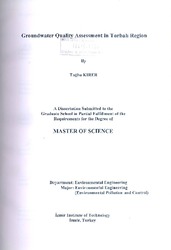Please use this identifier to cite or link to this item:
https://hdl.handle.net/11147/3074Full metadata record
| DC Field | Value | Language |
|---|---|---|
| dc.contributor.advisor | Tayfur, Gökmen | en |
| dc.contributor.author | Kırer, Tuğba | - |
| dc.date.accessioned | 2014-07-22T13:50:49Z | - |
| dc.date.available | 2014-07-22T13:50:49Z | - |
| dc.date.issued | 2002 | en |
| dc.identifier.uri | http://hdl.handle.net/11147/3074 | - |
| dc.description | Thesis (Master)--Izmir Institute of Technology, Environmental Engineering, Izmir, 2002 | en |
| dc.description | Includes bibliographical references (leaves: 70-72) | en |
| dc.description | Text in English; Abstract: Turkish and English | en |
| dc.description | iii, 72 leaves | en |
| dc.description.abstract | Groundwater is an important source of irrigation, drinking water and other human activities. With the growth in population, agricultural and industrial activities and the groundwater usage have increased dramatically. However, not only the groundwater use, but also has the level of contamination in groundwater increased. In TorbalI region, drinking water and irrigation water are supplied from wells which are drilled mostly without permission. Excessive abuse of fertilizers, and pesticides in agricultural activities and industries cause to contaminate the groundwater. In order to investigate the quality of the groundwater in this regIOn, sampling locations were determined taking the geology and industry of the region into account. The samples were collected monthly for ten months. In this study, water quality parameters which are pH, temperature, electrical conductivity, calcium, magnesium, potassium, sodium, chloride, alkalinity, nitrate, nitrite, ammonia, copper, chromium, cadmium, lead, zinc, chemical oxygen demand (COD), and cyanide were examined to determine the groundwater quality and relationship between the parameters and the sources of contamination. The samples were classified as hard water. All of the samples had bicarbonate alkalinity. The study revealed the existence of agricultural contamination. Nitrate concentrations of the groundwater samples increased in summer and the concentrations of nitrate were higher than the permissible limit in some of the wells. Heavy metal contamination was not detected in the region. The concentrations of the parameters were not constant during the monitoring study. This may be because the leachate of wastewaters which are discharged suddenly and discontinuously. | en |
| dc.language.iso | en | en_US |
| dc.publisher | Izmir Institute of Technology | en |
| dc.rights | info:eu-repo/semantics/openAccess | en_US |
| dc.subject.lcc | TD426. K57 2002 | en |
| dc.subject.lcsh | Groundwater--Pollution | en |
| dc.subject.lcsh | Groundwater--Quality | en |
| dc.subject.lcsh | Groundwater--Turkey | en |
| dc.title | Groundwater quality assessment in Torbalı Region | en_US |
| dc.type | Master Thesis | en_US |
| dc.institutionauthor | Kırer, Tuğba | - |
| dc.department | Thesis (Master)--İzmir Institute of Technology, Environmental Engineering | en_US |
| dc.relation.publicationcategory | Tez | en_US |
| item.grantfulltext | open | - |
| item.cerifentitytype | Publications | - |
| item.languageiso639-1 | en | - |
| item.openairecristype | http://purl.org/coar/resource_type/c_18cf | - |
| item.fulltext | With Fulltext | - |
| item.openairetype | Master Thesis | - |
| Appears in Collections: | Master Degree / Yüksek Lisans Tezleri Sürdürülebilir Yeşil Kampüs Koleksiyonu / Sustainable Green Campus Collection | |
Files in This Item:
| File | Description | Size | Format | |
|---|---|---|---|---|
| T000144.pdf | MasterThesis | 5 MB | Adobe PDF |  View/Open |
CORE Recommender
Page view(s)
118
checked on Jul 29, 2024
Download(s)
58
checked on Jul 29, 2024
Google ScholarTM
Check
Items in GCRIS Repository are protected by copyright, with all rights reserved, unless otherwise indicated.